¿Te interesa realizar un curso online de tècnicas del tejido en telar con Anna Champeney?Si te interesa aprender técnicas de diseño y tejido en telar de bajo lizo online, escríbanos y suscribir a nuestro boletín.
 Contacta con nosotros | Eco-friendly fabrics from Spain
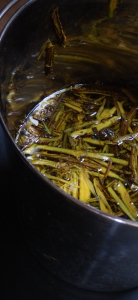 Barberry bark, one source of local and natural colour at Anna Champeney Estudio Textil (April 2012)
Barberry bark, madder root, dried cochineal and walnut husks are all sources of natural colour used to create the textiles at the weave studio of textile designer Anna Champeney in north Spain. The studio´s collections include limited edition double-weave linens, double-sided scarves in richly-coloured silk and wool, and a range of linen and wool textiles for interiors, including cushions, storage bags and decorative wall-dividers. The designs vary with each collection but what unites all these textiles is the rich and harmonious use of natural colour. The reality is that the colours produced by natural dyes are different to most synthetic dyes today because the complex formulas of natural plant dyes – a single plant may contain several dyes which combine to produce a particularly rich or subtle colour – are usually too expensive to produce in the context of industrial textile production.
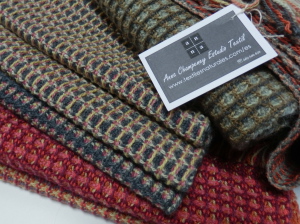 Anna Champeney textile collection 2011-12 - waffle weave scarves in silk and wool with natural dyes
This makes natural dyes the ideal choice for certain designers and specialist artisans who seek to produce a high-end product and who also care about the way that textiles are made today and the impact on the natural world. “I started working with natural dyes as it seemed the obvious choice given the location of the textile studio in rural north Spain where there was an abundance of natural dyestuffs. Of course, I was also interested in making a more organic or natural product. For me this meant sourcing dyestuffs as locally as possible, using processes which were efficient, with little waste, and avoiding chrome as a fixative ” commented Champeney.
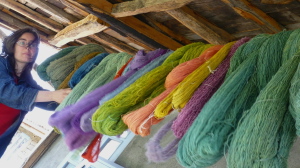 Drying yarns dyed with lichen, gorse, indigo and madder at Anna Champeney Estudio Textil in north Spain
The quality of the colours produced was also a factor. “As a textile designer and craft weaver you often find yourself limited by the commercial colour ranges. By dyeing my own colours I can achieve incredibly varied and subtle colour blends which lend a special quality to the finished textiles. This gives me a certain freedom which industrial designers simply do not have”. Marta Bahillo – Spanish knit designer – opts for natural dyes
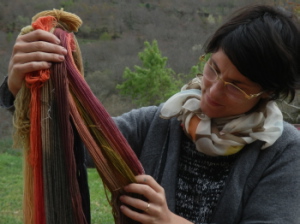 Marta Bahillo, Spansh knit designer, discovers the subtle colours of natural dyes
Marta Bahillo, a young Spanish knit designer is also moving in this direction which was why she decided to spend time at AC Estudio Texil for some intensive colour tuition. Working with natural dyes for the first time was nothing short of a revelation for this designer, whose working practice up until now always involved off-the-peg synthetically-coloured yarns. “I really feel the course has changed me because I see colour in a different way now”, commented Bahillo, “I can see subtle changes in tone which I didn´t notice before”. Moreover, Bahillo was particularly struck by the sheer variety and richness of the colours obtained using natural dyes. In the context of her work as a knit designer Bahillo sees definite advantages in being able to have a greater control over the final result. Working directly with the dyes gives her a far greater creative involvement in the process, leading her to comment “As a textile designer I feel more confident than before”. Natural Dyes and Fashion But what about the dictates of fashion which result in certain colours dominating the market every year. Is it important for these new designers to look at colour forecasts for fashion? Champeney thinks not. “My clients tend to have a confidence in their own sense of style and colour and choose colourways which suit them rather than to follow the dictates of the fashion industry. They may combine my textiles with clothing from branded fashion but their style is definitely an individual style which is unique to them. The challenge for independent designers or makers not to follow fashion but to make textiles which are so distinctive and beautiful that each piece becomes a personal classic in its own right”. More information:
- Inquiries about Anna Champeney Estudio Textil´s limited edition textile collections – please contact the studio.
- Textilesnaturales hopes to feature Marta Bahillo again in a future feature.
One-of-a-kind linen crêpe dress fabrics from Anna Champeney Estudio Textil Spring 2011 Antique linen flirts with volume …
 Sample reference: 02/2011M series/white Sample reference: 02/2011M series/white- Materials: linen and Japanese wool crêpe
- Design: AC Estudio Textil, Galicia
- Manufacture: hand-woven as a one-off length of fabric (sample)
-
 Sample reference: 02/2011M series/b&w Sample reference: 02/2011M series/b&w- Materials: linen, silk, Japanese wool crêpe
- Design: AC Estudio Textil, Galicia
- Manufacture: hand-woven as a one-off length of fabric (sample)
 individually hand-woven bespoke fabrics at AC Estudio Textil Invitation to Spanish fashion designers: AC Estudio Textil invites seeks interest from fashion designers, particularly in Galicia, Spain, who are interested in creative collaborations. Please refer to the post about Danish fabric designer-weaver Lotte Dalgaard and Copenhagen fashion designer Ann Schmidt to see the kind of potential collaboration which might be possible and contact us Ribeira Sacra handwoven textile and basketry workshops are worth a visit so after you have “done” the boat trip and visited the monasteries, follow our route around the picturesque village of Cristosende for a truly different experience of the Ribeira Sacra. A visit to this scenic hamlet in August not only means you can visit the open village craft studios to see and buy hand-made textiles and rare baskets and have a guided visit. In the same village you can also visit the family-run bodega, go for a shady stroll with some stunning scenery (print out the information below) and then finish up in the Cristosende manor house bar for a drink, ice-cream or even a meal (reserve beforehand). There are few such pretty villages in the locality of such a small size which offer you so many possibilities. Let us know how you get on by adding a comment! Map of How to Get to Cristosende About Cristosende (15 minutes from Castro Caldelas, overlooking the River Sil) 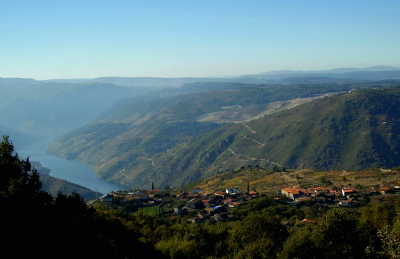 Cristosende is arguably one of the prettiest in the Ribeira Sacra (Ourense), with many tiny stone bodegas still used by local people to make wine and stunning views directly over the River Sil Canyon with its steeply-terraced, hand-worked, vineyards which produce the local mencia and godello wines. The village is not an artificial tourist village, however, but a real working village, with all the small businesses run by local families. It experiences a brief buzz during the annual fiestas, at the beginning of August, and for the rest of the year it is a haven of peace and quiet, with fewer than 40 all-year round inhabitants. Cristosende is arguably one of the prettiest in the Ribeira Sacra (Ourense), with many tiny stone bodegas still used by local people to make wine and stunning views directly over the River Sil Canyon with its steeply-terraced, hand-worked, vineyards which produce the local mencia and godello wines. The village is not an artificial tourist village, however, but a real working village, with all the small businesses run by local families. It experiences a brief buzz during the annual fiestas, at the beginning of August, and for the rest of the year it is a haven of peace and quiet, with fewer than 40 all-year round inhabitants.
Suggestions for things to do in Cristosende in the Riberia Sacra this August 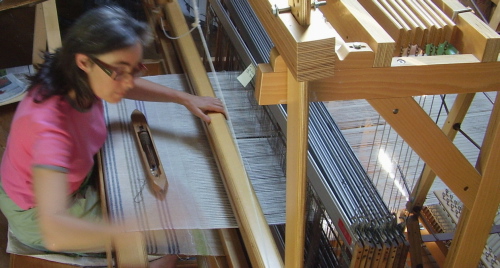 Activity 1 – Visit to the only weaving and basketry workshops in the whole of the Ribeira Sacra – Anna Champeney Textile Studio and Lluis Grau Basketry Activity 1 – Visit to the only weaving and basketry workshops in the whole of the Ribeira Sacra – Anna Champeney Textile Studio and Lluis Grau Basketry
Opening Hours –1 – 31 August 2010 – Tuesday – Sunday – 10.30 – 1.30pm / 6.00 – 8.30pm.
- Free access to shop and exhibition areas.
- Guided visits during opening hours (up to 45 minutes before closing time) on request. (Cost: 2,5€ per individual, group tarifs according to numbers)
Rest of the Year – closed to the public except for guided tours / visits by appointment (T. +34 669 600 620)  Products and Description: Products and Description:
- Unusual hand-woven traditional designs and techniques and range of own-label products.
- Rare Spanish baskets with local designs from the Ribeira Sacra, Galicia and the north of Spain.
- Opportunity for Guided Workshop Tours (August)
About Weaving and Basket Making in the Ribeira Sacra – Weaving and basketry were both traditional Spanish crafts that were part of everyday life in the Ribeira Sacra in Galicia just 50 years ago, with hundreds of weavers and basketmakers at work. Anna Champeney and Lluis Grau keep the tradicions alive and develop them further in their small but beautifully-restored craft workshops. The workshops have information panels and offer guided tours on request. More about Anna Champeney Textile Studio in Cristosende, About Lluis Grau Basketmaker Activity 2 – Walking route in and around Cristosende (A Teixeira) (about 30 minutes) 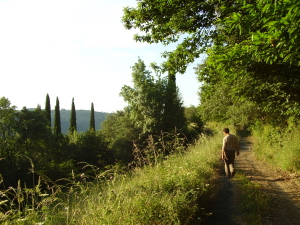 A relaxing stroll which is a circular route along peaceful country lanes, some of which is through beautifully shady sweet chestnut groves. Print this route out as it is not signposted. It is very easy to follow and has wonderful views over the village, the vineyards and the River Sil itself. Walking is, perhaps, the best way to experience the Ribeira Sacra, and a refreshing change to car-based tourism. A relaxing stroll which is a circular route along peaceful country lanes, some of which is through beautifully shady sweet chestnut groves. Print this route out as it is not signposted. It is very easy to follow and has wonderful views over the village, the vineyards and the River Sil itself. Walking is, perhaps, the best way to experience the Ribeira Sacra, and a refreshing change to car-based tourism.
Starting point: Communal public wash-place (locals still wash clothes and rugs in this roofed water-tank) in the centre of the village (a roofed water tank near the signpost to the Anna Champeney Textile Workshop). You can drink the spring water from the more modern of two water fountains here.
- Walk out of the village along the country lane, past the village recycling point, towards A Teixeira. Pretty views of Cristosende.
- Shortly after the road curves to the left and begins to climb you take a steep asphalted country lane on the right. This takes you by the hamlet of O Barrio and past Casa Pital with its majestic cypress trees.
- Continue walking straight on through shady sweet chestnut groves until you come to a –T-junction, where you will see a village spring set into a rock on the right. This is drinkable.
- Then turn right, down hairpin bends leading back into Cristosende. Enjoy the wonderful views, this time over the River Sil Canyon itself.
- This takes you back into the village of Cristosende. Take the first right turn into the village to pass by the village winery, Viña Pederneira. Continue on down through the village to the wash-place.
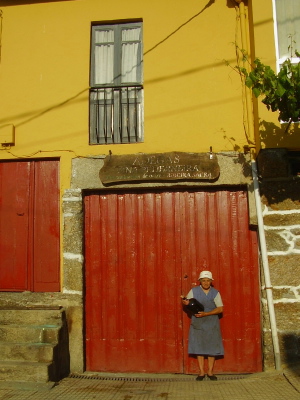 Activity 3: Viña Pederneira (D.O. Ribeira Sacra) – The village winery Activity 3: Viña Pederneira (D.O. Ribeira Sacra) – The village winery
- Opening hours – whenever a member of the family is at home (although avoid siesta time!), rather than working in the vineyards. If the bodega door is not open then don´t be afraid to shout “Hola” loudly.
- Products: Gift packs of 3 bottles of mencia and godello wine. Wine boxes also available. Ask about local aguardiente (the delicious local spirit made from distilling grapeskins, flavoured with coffee or herbs)
- Description: The small family-run winery or bodega in Cristosende makes wine exclusively from its own mencia and godello grapes. Although small bodegas like Viña Perderneira don´t have the public profile of the larger, more commercial wineries you will see publicised in tourist brochures and in large road signs, they represent the truly authentic face of wine-making tradition of the Ribeira Sacra. Again, unlike some of the other wineries which apparently buy up grapes from other regions, all the wine from Viña Perderneira has been made from local vineyards in and around Crisotsende.
Activity 4 – Eating and Drinking in Cristosende 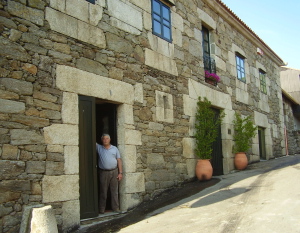 After your visit to the craft workshops you can enjoy a drink or a meal (with prior reservation – (T. +34 988 20 75 29) at the attractive village manor house, the Casa Grande. The walled courtyard is refreshingly cool in summer. Another alternative is to bring your own picnic and sit out at one of the village merenderos (picnic areas), some of which have drinking fountains. Please remember to take your rubbish with you and leave the marble tables clean (Cristosende villagers like to play cards there on summer afternoons). After your visit to the craft workshops you can enjoy a drink or a meal (with prior reservation – (T. +34 988 20 75 29) at the attractive village manor house, the Casa Grande. The walled courtyard is refreshingly cool in summer. Another alternative is to bring your own picnic and sit out at one of the village merenderos (picnic areas), some of which have drinking fountains. Please remember to take your rubbish with you and leave the marble tables clean (Cristosende villagers like to play cards there on summer afternoons).
Staying in Cristosende – Tourist Accommodation in Cristosende The village has several options for staying longer including craft holidays, should you wish to return another time:
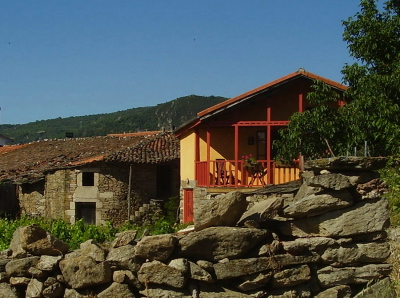 Casa dos Artesans holiday cottage (shown in photo) is ideal if you are looking for privacy, value-for-money, and space of your own. Advance bookings only. 2 spacious bedrooms. Sleeps 2 – 5 people. (585€ per week + 13.50€ for extra single bed for 5th person). (T. +34 669 600 620) Casa dos Artesans Holiday Cottage Casa dos Artesans holiday cottage (shown in photo) is ideal if you are looking for privacy, value-for-money, and space of your own. Advance bookings only. 2 spacious bedrooms. Sleeps 2 – 5 people. (585€ per week + 13.50€ for extra single bed for 5th person). (T. +34 669 600 620) Casa dos Artesans Holiday Cottage Craft Holidays – Anna Champeney, textile weaver, and Lluis Grau, basket weaver, offer residential craft holidays and courses of up to 3 weeks duration so you can combine a stay in the Ribeira Sacra with learning how to make your own hand-woven textile or basket. Craft Holidays – Anna Champeney, textile weaver, and Lluis Grau, basket weaver, offer residential craft holidays and courses of up to 3 weeks duration so you can combine a stay in the Ribeira Sacra with learning how to make your own hand-woven textile or basket. - The Casa Grande is the village manor house and offers spacious double rooms including one with disabled access, with breakfast and meals available at the restaurant (meals reserved in advance – (T. +34 988 20 75 29)
Village Life in Cristosende: Background As you can see, Cristosende is a dynamic little village (especially given its tiny population of fewer than 40 all-year round inhabitants), in having a number of local, family-run businesses – craft, wine and tourist accommodation. Many villagers make their own wine and cultivate their own vegetable gardens and thanks to them and the small businesses, other newcomers are now being attracted to the village both to live and to spend holidays. As a result quite a number of village houses and bodegas have been sympathetically-restored over the last 8 years, leaving the structure of the original buildings untouched, with the authentic local stone walls visible, traditional roof tiles and painted wooden windows and balconies. This in itself is making Cristosende an ever-more attractive village, both to live in and to visit. We hope you enjoy your visit to Cristosende this August. Please ensure that Cristosende villagers continue to enjoy having visitors in future – Leave any rubbish in the bins provided , keep your dogs on leads, and please don´t enter private gardens, vineyards and buildings.
Around Cristosende – Other Places of Interest
- Castro Caldelas – with its historic castle and shops and bars (15 minutes by car) and Centro Comarcal (oppisite the castle) Tourist Information Office
- Santa Cristina Monastery (Parada do Sil)– One of the Romanesque monasteries which have given the area its name, Ribeira Sacra (Sacred Riverside) – (30 minutes by car)
- Vilariñofrío Roman Bridge (Paraa do Sil) – (about 10 – 15 minutes by car)
- Niñodaguia Pottery – Cerámica Agustín – One of the last traditional potters. The honey-coloured pottery here is not to be missed. (25 minutes by car situated on the main road to between Castro Caldelas and Ourense)
- Monforte de Lemos – the main town of the Ribeira Sacra (35 minutes by car)
- Ourense City – provincial capital with its old quarter full of tapas bars, and hot springs
- Gundivós Pottery – The unusual black pottery of the region probably has very ancient origins and you won´t see anything like it anwhere else. There are two potteries making Gundivós ceramics, both near Doade (Lugo province). (About 50 minutes by car)
- Allariz – superbly-restored historic town (1 hour by car) with a range of craft shops, local product shops and Galician designer clothes shops
|
Pago seguro
 NUEVO Octubre 2023 Curso presencial setmanal de teixits de baix lliç (Girona)!Un curso nou, setmanal (3h) a Sant Gregori, Girona, amb l'Anna Champeney. Trimensual, plaças limitadas).
Octobre 2023. Ven a aprender a diseñar y realizar tejidos en telar de bajo lizo a mano. Docente: Anna Champeney, profesional desde 2004, con marca textil propia, experta en tejido de bajo lizo, docente en la Escola Massana, Barcelona.
 Haga clic aquí para informarte |






 Sample reference: 02/2011M series/white
Sample reference: 02/2011M series/white Sample reference: 02/2011M series/b&w
Sample reference: 02/2011M series/b&w
 Cristosende is arguably one of the prettiest in the Ribeira Sacra (Ourense), with many tiny stone bodegas still used by local people to make wine and stunning views directly over the River Sil Canyon with its steeply-terraced, hand-worked, vineyards which produce the local mencia and godello wines. The village is not an artificial tourist village, however, but a real working village, with all the small businesses run by local families. It experiences a brief buzz during the annual fiestas, at the beginning of August, and for the rest of the year it is a haven of peace and quiet, with fewer than 40 all-year round inhabitants.
Cristosende is arguably one of the prettiest in the Ribeira Sacra (Ourense), with many tiny stone bodegas still used by local people to make wine and stunning views directly over the River Sil Canyon with its steeply-terraced, hand-worked, vineyards which produce the local mencia and godello wines. The village is not an artificial tourist village, however, but a real working village, with all the small businesses run by local families. It experiences a brief buzz during the annual fiestas, at the beginning of August, and for the rest of the year it is a haven of peace and quiet, with fewer than 40 all-year round inhabitants. Activity 1
Activity 1  Products and Description:
Products and Description:  A relaxing stroll which is a circular route along peaceful country lanes, some of which is through beautifully shady sweet chestnut groves. Print this route out as it is not signposted. It is very easy to follow and has wonderful views over the village, the vineyards and the River Sil itself. Walking is, perhaps, the best way to experience the Ribeira Sacra, and a refreshing change to car-based tourism.
A relaxing stroll which is a circular route along peaceful country lanes, some of which is through beautifully shady sweet chestnut groves. Print this route out as it is not signposted. It is very easy to follow and has wonderful views over the village, the vineyards and the River Sil itself. Walking is, perhaps, the best way to experience the Ribeira Sacra, and a refreshing change to car-based tourism.  Activity 3:
Activity 3:  After your visit to the craft workshops you can enjoy a drink or a meal (with prior reservation – (T. +34 988 20 75 29) at the attractive village manor house, the Casa Grande. The walled courtyard is refreshingly cool in summer. Another alternative is to bring your own picnic and sit out at one of the village merenderos (picnic areas), some of which have drinking fountains. Please remember to take your rubbish with you and leave the marble tables clean (Cristosende villagers like to play cards there on summer afternoons).
After your visit to the craft workshops you can enjoy a drink or a meal (with prior reservation – (T. +34 988 20 75 29) at the attractive village manor house, the Casa Grande. The walled courtyard is refreshingly cool in summer. Another alternative is to bring your own picnic and sit out at one of the village merenderos (picnic areas), some of which have drinking fountains. Please remember to take your rubbish with you and leave the marble tables clean (Cristosende villagers like to play cards there on summer afternoons). Casa dos Artesans holiday cottage (shown in photo) is ideal if you are looking for privacy, value-for-money, and space of your own. Advance bookings only. 2 spacious bedrooms. Sleeps 2 – 5 people. (585€ per week + 13.50€ for extra single bed for 5th person). (T. +34 669 600 620)
Casa dos Artesans holiday cottage (shown in photo) is ideal if you are looking for privacy, value-for-money, and space of your own. Advance bookings only. 2 spacious bedrooms. Sleeps 2 – 5 people. (585€ per week + 13.50€ for extra single bed for 5th person). (T. +34 669 600 620)  Craft Holidays – Anna Champeney, textile weaver, and Lluis Grau, basket weaver, offer residential craft holidays and courses of up to 3 weeks duration so you can combine a stay in the Ribeira Sacra with learning how to make your own hand-woven textile or basket.
Craft Holidays – Anna Champeney, textile weaver, and Lluis Grau, basket weaver, offer residential craft holidays and courses of up to 3 weeks duration so you can combine a stay in the Ribeira Sacra with learning how to make your own hand-woven textile or basket. 


